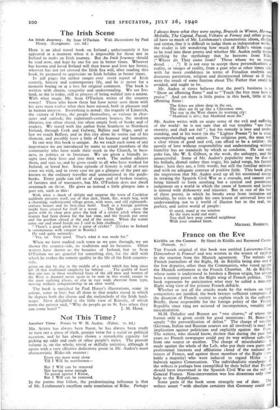The Irish Scene
An Irish Journey. By Sean O'Faolain. With illustrations by Paul Henry. (Longmans. 12s. 6d.) HERE is an ideal travel book on Ireland ; unfortunately it has appeared at a moment when it is impossible for those not in Ireland to make an Irish journey. But An Irish Yourney should be read now, and kept by one for use in better times. Whoever has known and loved Ireland will then know and love her better; whoever has not yet crossed the Irish Sea will, after reading this book, be prepared to appreciate an Irish holiday in better times.
In 308 pages the author ranges over every aspect of Irish scenery, history and contemporary life, and he is never for a moment boring or at a loss for original comment. The book is written with charm, sympathy and understanding. We see Ire- land, as she is today, still in process of being welded into a nation. With what magic Mr. Sean O'Faolain writes of the country towns! Those who know them but have never seen them with his eyes must realise what they have missed, both in pleasure and in human interest. Everything is noted: the tragedy of Limerick, the victory of Derry, the people themselves, so various in char- acter and outlook; the eighteenth-century houses; the modern libraries, too often closed, too often empty both of books and cf readers. We travel with the author from Southern to Northern Ireland, through Cork and Galway, Ballina and Sligo, until at last we reach Belfast; and in this city alone he seems out of his element, and possibly loses a little of his humour and humanity.
In one way this book is unique. As we reach each town of any importance we are introduced by name to actual members of the community who have made their mark in the Church, in busi- ness, in politics or in literature. We are given a friendly in- sight into their lives and into their work. The author admires them, and says so, and he gives credit to all who have worked for Ireland, or loved her. Some episode of history is told of every town we visit, and in every case we get a glimpse of the past un- known to the ordinary traveller and unmentioned in the guide- books. Every guide can tell us. of sieges and of broken treaties, of famines and of massacres, but Mr. O'Faolain does not dwell overmuch on these. He gives us instead a little glimpse into a past era, such as this:
With what a shock of delight and surprise the town of Castlebar suddenly presents itself, out of that dark, blank, flat, windy bog, with a charming, sophisticated village green, with trees, and old eighteenth- century houses and its first-class hotel. Such as a foreign garrison might have created for itself in a waste . . The light . . . gave the green with its close grey grass the look of a cricket pitch where the stumps had been drawn for the last time, and the boards put away and the pavilion closed at the end of the season. When the waiter came out and stood beside me I said to him chaffingly: "There's a good pitch for a game of cricket." (Cricket to Ireland is synonymous with croquet in Russia.) He said quite seriously: "Yes, sir. Very good. That's what it was made for."
When we have studied each town as we pass through, we are shown the country-side, its traditions and its beauties. Other writers have shown us the beauties of Ireland, but to Sean O'Faolain we are grateful for something else, for the skill with which he evokes the remote quality in the life of the Irish country- side, going on day by day in the middle of a world which has long since left all that traditional simplicity far behind . . . The quality of heart that one sees in these weathered faces of the old men and women of the West is doomed never again to be seen in this world, except in the most outlying places, or else in rare souls aberrant from type, moving without companionship in an alien world.
The book is enriched by Paul Henry's illustrations some in colour, some in line; but all done in that tender mood in which he depicts both the charm and the melancholy of the Irish land- scape. Most delightful is the little view of Kinsale, of which town the painter said, "Why do people go to St. Ives when they






























 Previous page
Previous page